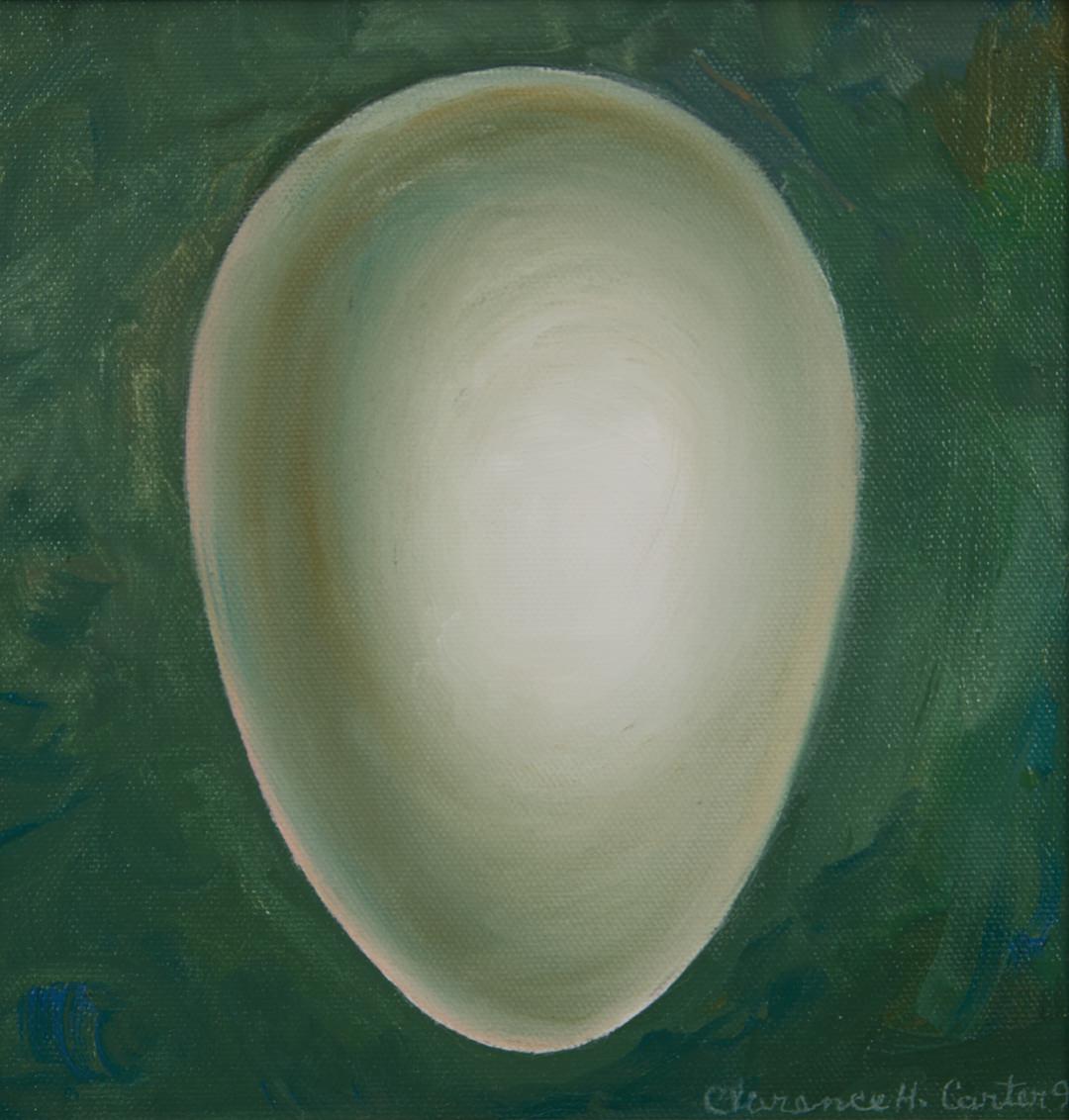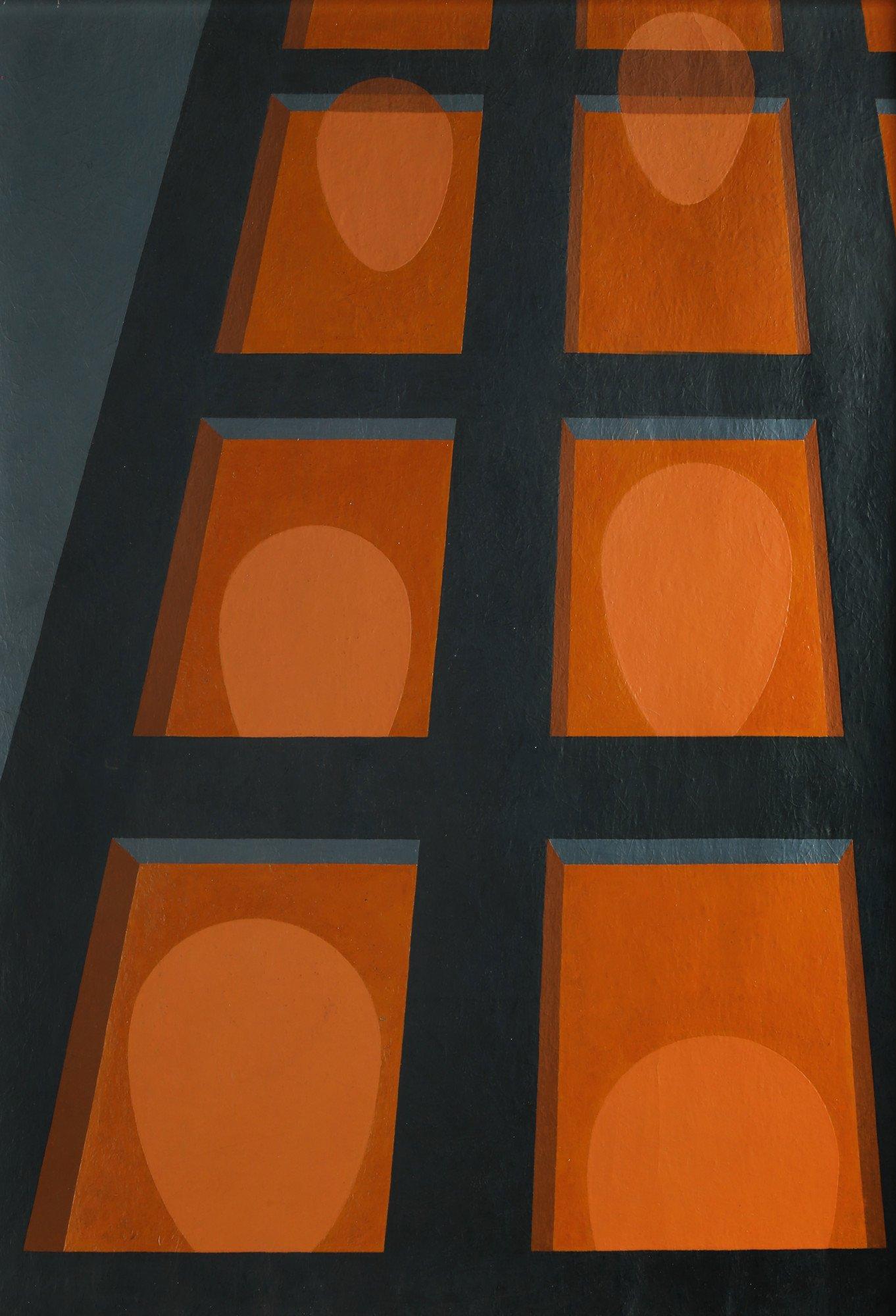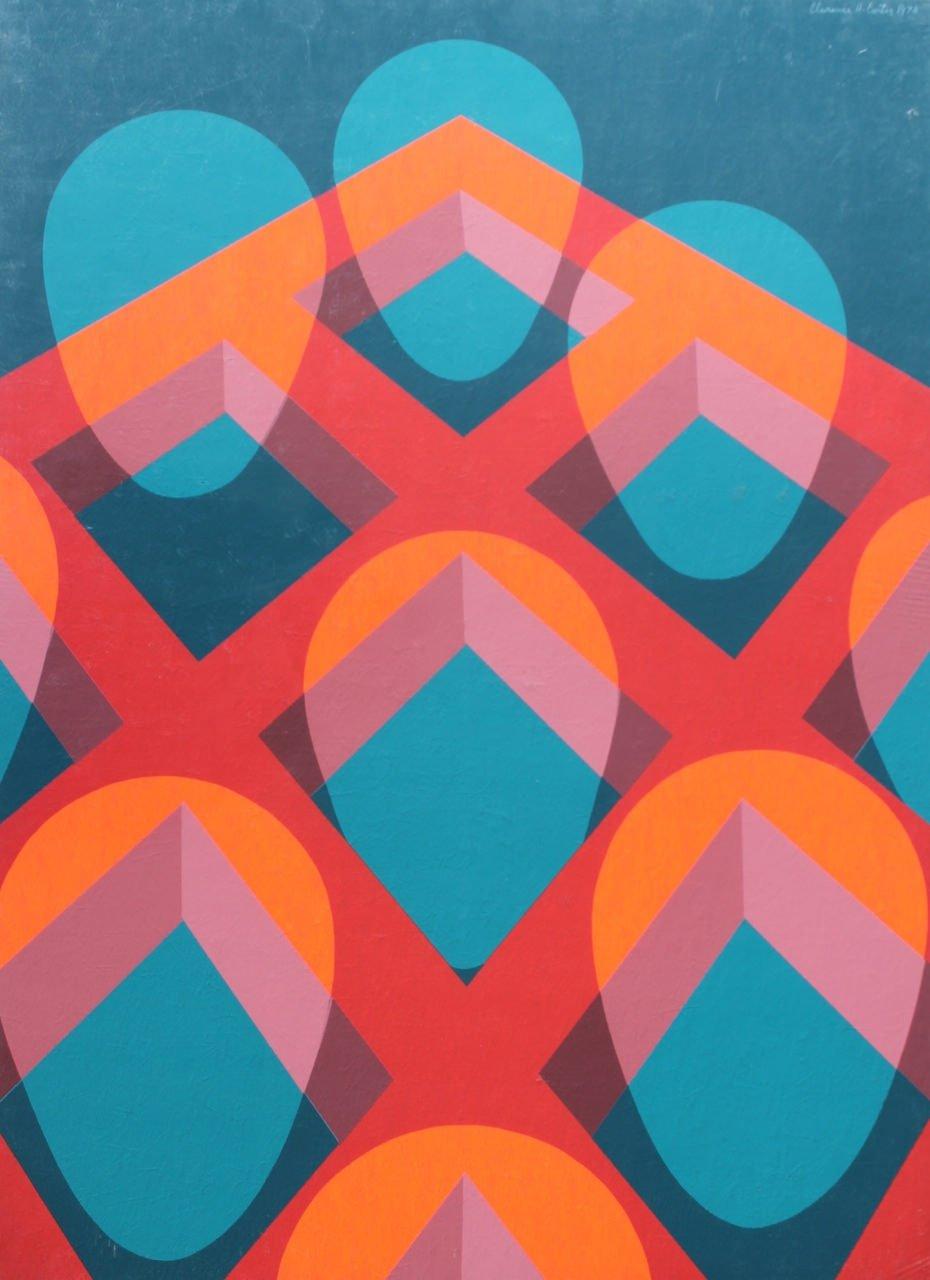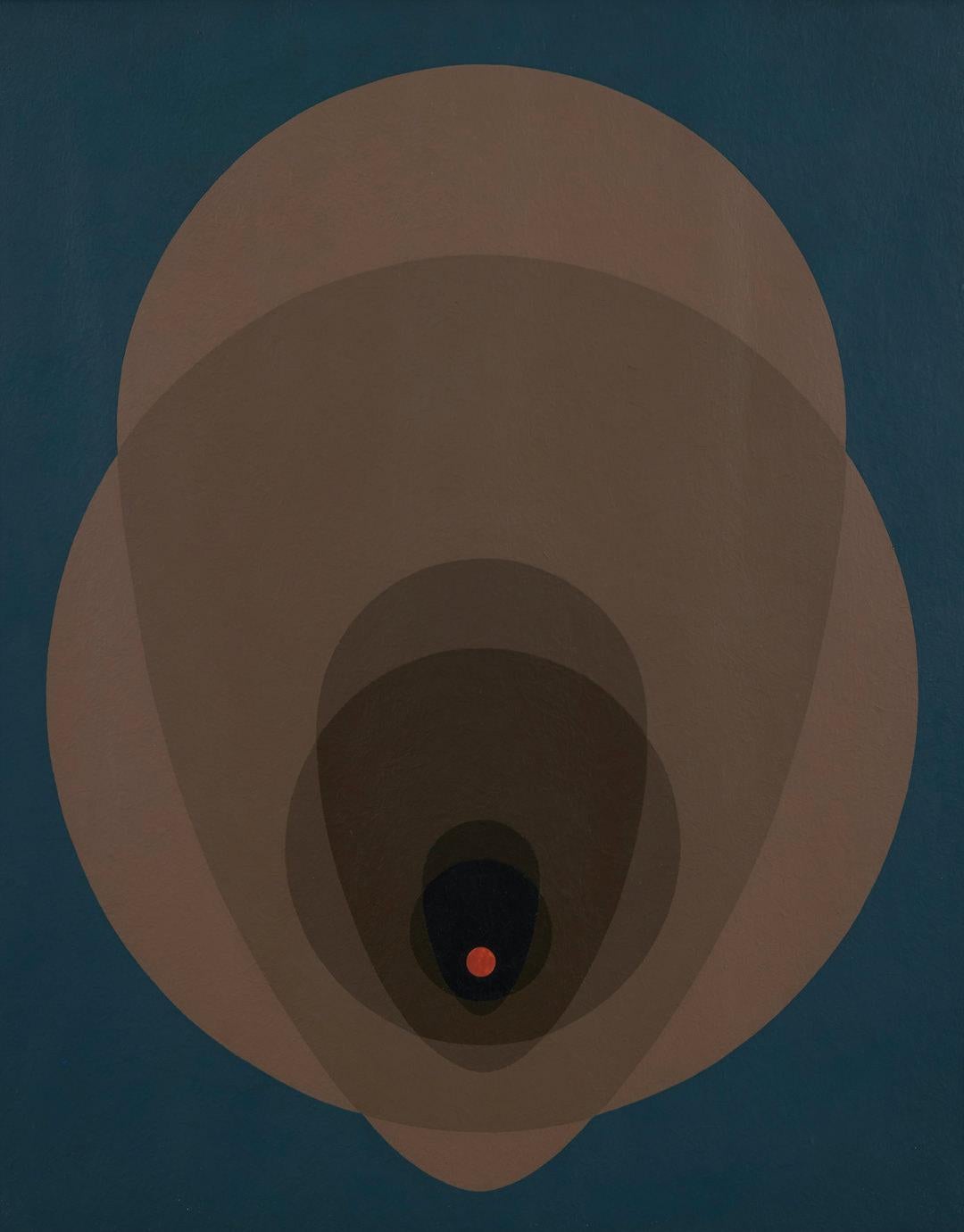Items Similar to Medieval Heads, mid-century figural surrealist acrylic painting
Want more images or videos?
Request additional images or videos from the seller
1 of 15
Clarence Holbrook CarterMedieval Heads, mid-century figural surrealist acrylic painting1966
1966
About the Item
Clarence Holbrook Carter (American, 1904-2000)
Cicada, c. 1960s
Watercolor on scintilla
30 x 20 inches
Clarence Holbrook Carter achieved a level of national artistic success that was nearly unprecedented among Cleveland School artists of his day, with representation by major New York dealers, scores of awards and solo exhibits, and streams of praise flowing from pens of the top art critics. Over the course of his 60+ year career Carter evolved from an exceptionally fine American Scene painter capable of evoking deep reservoirs of mood, into an abstractionist with a strongly surrealist bent.
While his two bodies of work seem at first to be worlds apart, owing to their different formal vocabularies, they, in fact, explore virtually the same subject: the nexus between life and death and the transition from earth to spirit. The early work finds its expressive power through specific people, events, and landscapes—most of which are drawn from his experiences growing up in the river town of Portsmouth, Ohio—while the later work from the 1960s on evokes potent states of being through pure flat shape, color and form that read as universals. As his primary form he adopted the ovoid or egg shape, endowing it with varying degrees of transparency. Alone or in multiples, the egg moves through Carter’s landscapes and architectural settings like a sentient spirit on a restless quest.
Born and raised in southern Ohio along the banks of the mercurial Ohio River and its treacherous floods, Carter developed a love of drawing as a child, and was encouraged by both his parents. He was self-directed, found inspiration all around him, and was strongly encouraged by the fact that his teenage work consistently captured art prizes in county and state fairs. Although money was tight after his father (who was a postal worker) died suddenly of a stroke, Carter’s mother supported his desire to study at the Cleveland School of Art from 1923-27, where he trained under painters Henry Keller, Frank Wilcox and Paul Travis.
In the summer of 1927, Carter studied in Capri with the modernist Hans Hofmann, where he carried out compositional exercises in charcoal and paint, recording the lucid spatial order of stairs, walls, roofs, arches and other elements of the island’s compressed architecture. Returning to Cleveland in 1929, Carter had his first solo show, and through Milliken taught studio classes at the Cleveland Museum of Art from 1930-37. In 1934, he worked under the auspices of the Public Works of Art Project and won a commission to paint two murals in Cleveland’s Public Auditorium. In 1936, he painted a post office mural in Ravenna, Ohio, as well as one for the post office in his hometown of Portsmouth, where his father had worked. He then headed the Northeast Ohio division of the painting projects arm of the Works Progress Administration, a subsequent government art program. In 1938, he moved to Pittsburgh to teach at the Carnegie Institute of Technology until 1944. Carter’s American Scene paintings of the ’30s and ’40s, which launched his artistic star, are the works for which the artist remains best known.
During and immediately after World War II, Clarence Carter realized his attraction to bold pattern, dramatic perspective and eye-catching hard-edged design was a poor fit with the prevailing style of Abstract Expressionism. Fortunately, these same hallmarks of his style were prized within the realm of commercial art. Thus, from 1944-1959, Carter became a veritable “Mad Man [Madison Avenue Man],” designing ambitious series of advertisements for major corporations such as Alcoa and The National City Bank of New York (Citibank) which appeared on the back covers of Fortune magazine, and on inside pages of Time, Newsweek, Business Week, and US News & World Report. Carter described this period of his life as one of incredible inventiveness and imagination. It freed him up to be far more experimental in his approach to image-making.
Around 1964 Carter acknowledged a need to break from the confines of representational painting. Once Carter had found a potent symbol in the egg, he used it to create an astounding body of imagery for the rest of his life. Among the most ambitious of all his later paintings were his Transections, a theological term meaning to cross, specifically between life and death.
- Creator:Clarence Holbrook Carter (1904-2000, American)
- Creation Year:1966
- Dimensions:Height: 23.5 in (59.69 cm)Width: 30 in (76.2 cm)
- Medium:
- Movement & Style:
- Period:
- Condition:
- Gallery Location:Beachwood, OH
- Reference Number:1stDibs: LU176829628192
About the Seller
No Reviews Yet
Vetted Seller
These experienced sellers undergo a comprehensive evaluation by our team of in-house experts.
Established in 1975
1stDibs seller since 2022
9 sales on 1stDibs
Typical response time: <1 hour
- ShippingRetrieving quote...Ships From: Beachwood, OH
- Return PolicyA return for this item may be initiated within 14 days of delivery.
More From This SellerView All
- Ovoid, geometrical figural surrealist acrylic painting, Cleveland School artistBy Clarence Holbrook CarterLocated in Beachwood, OHClarence Holbrook Carter (American, 1904-2000) Ovoid, 1992 Acrylic on canvas Signed and dated lower right 7.75 x 7.75 inches 9 x 9 inches, framed Clarence Holbrook Carter achieved a...Category
1990s American Modern Abstract Paintings
MaterialsAcrylic
- Transection w/ Architectural Forms, Geometrical Figurative Abstract AcrylicBy Clarence Holbrook CarterLocated in Beachwood, OHClarence Holbrook Carter (American, 1904-2000) Transection with Architectural Forms, c. 1980s Acrylic and graphite on board 12 x 20 inches A surrealist mid-century figural abstract ...Category
1980s American Modern Abstract Paintings
MaterialsAcrylic, Graphite
- In the Window, Ovoid Shapes Floating Through WindowsBy Clarence Holbrook CarterLocated in Beachwood, OHClarence Holbrook Carter (American, 1904-2000) In the Window, 1973 Acrylic and collage on scintilla Signed and dated lower right 30 x 22 inches A surrealist mid-century figural abs...Category
1970s American Modern Abstract Paintings
MaterialsAcrylic
- Transection No. 3, Ovoid Geometrical Figural Abstract Neon Acrylic PaintingBy Clarence Holbrook CarterLocated in Beachwood, OHClarence Holbrook Carter (American, 1904-2000) Transection No. 3, 1972 Acrylic on paper Signed and dated upper right 30 x 22 inches Provenance: Collection of William H. Milliken Cl...Category
1970s American Modern Abstract Paintings
MaterialsAcrylic
- Seeing Egg No. 2, Surrealist Ovoid acrylic painting, Figural AbstractBy Clarence Holbrook CarterLocated in Beachwood, OHClarence Holbrook Carter (American, 1904-2000) Seeing Egg No. 2, 1965 Acrylic and collage on scintilla Signed and dated upper right 30 x 22 inches 34 x 29 inches, framed A surrealis...Category
1960s American Modern Abstract Paintings
MaterialsAcrylic
- Mandala No. 15, Abstract Ovoid Geometrical Mid-Century Painting Cleveland SchoolBy Clarence Holbrook CarterLocated in Beachwood, OHClarence Holbrook Carter (American, 1904-2000) Mandala No. 15, 1969 Acrylic on paper Signed and dated verso 27.5 x 22 inches Clarence Holbrook Carter achieved a level of national ar...Category
1960s American Modern Abstract Paintings
MaterialsAcrylic
You May Also Like
- Johnny Hodges - The Big Sound (Grammy, Album Art, Iconic, Rock and Roll, Pop)By Kerry SmithLocated in Kansas City, MOKerry Smith Johnny Hodges - The Big Sound Mixed Media on Crescent board Year: 2016 Size: 21x20in Signed, dated by hand COA provided Ref.: 91-0194 ----------------------------------...Category
2010s American Modern Figurative Paintings
MaterialsMixed Media, Acrylic, Gouache, Board
- R.E.M. - Murmur (Grammy, Album Art, Iconic, Rock and Roll, Pop, Legendary)By Kerry SmithLocated in Kansas City, MOKerry Smith R.E.M. - Murmur Mixed Media on Crescent board Year: 2022 Size: 21x20in Signed, dated by hand COA provided Ref.: 924802-1633 --------------------------------------- "Of...Category
2010s American Modern Figurative Paintings
MaterialsAcrylic, Gouache, Board, Mixed Media
- Untitled Figurative Abstract PaintingBy Brendan McKeonLocated in Houston, TXUntitled red figurative abstract painting with various nude figures holding various objects by Portland, Oregon artist Brendan McKeon. The canvas is not currently framed.Category
Late 20th Century American Modern Figurative Paintings
MaterialsAcrylic
- Golfer Swinging, Vintage 7 Up Ad "Get Real Action" in Green and Yellow - GolfBy Bob PeakLocated in Miami, FLThis strobe-like dynamic composition with bright and bold colors reflects the energetic taste of the 7 Up brand. It lies somewhere between abstraction and figuration. Peaks' use of b...Category
1960s American Modern Figurative Paintings
MaterialsAcrylic, Illustration Board
- Led Zeppelin - Houses Of The Holy (Grammy, Album Art, Iconic, Rock and Roll)By Kerry SmithLocated in Kansas City, MOKerry Smith Led Zeppelin - Houses Of The Holy Mixed Media on Crescent board Year: 2018 Size: 21x20in Signed, dated by hand COA provided Ref.: 924802-1632 --------------------------...Category
2010s American Modern Figurative Paintings
MaterialsMixed Media, Acrylic, Gouache, Board
- The Magician oil and tempera painting by Julio de DiegoBy Julio de DiegoLocated in Hudson, NYJulio De Diego’s Atomic Series paintings made an extraordinary statement regarding the shock and fear that accompanied the dawn of the nuclear age. In the artist’s own words, “Scientists were working secretly to develop formidable powers taken from the mysterious depths of the earth - with the power to make the earth useless! Then, the EXPLOSION! . . . we entered the Atomic Age, and from there the neo-Atomic war begins. Explosions fell everywhere and man kept on fighting, discovering he could fight without flesh.” To execute these works, De Diego developed a technique of using tempera underpainting before applying layer upon layer of pigmented oil glazes. The result is paintings with surfaces which were described as “bonelike” in quality. The forms seem to float freely, creating a three-dimensional visual effect. In the 1954 book The Modern Renaissance in American Art, author Ralph Pearson summarizes the series as “a fantastic interpretation of a weighty theme. Perhaps it is well to let fantasy and irony appear to lighten the devastating impact. By inverse action, they may in fact increase its weight.” Exhibited 1964 Marion Koogler McNay Art Institute, San Antonio, Texas This work retains its original frame which measures 54" x 42" x 2" About this artist: Julio De Diego crafted a formidable persona within the artistic developments and political struggles of his time. The artist characterized his own work as “lyrical,” explaining, “through the years, the surrealists, the social-conscious painters and the others tried to adopt me, but I went my own way, good, bad or indifferent.” [1] His independence manifested early in life when de Diego left his parent’s home in Madrid, Spain, in adolescence following his father’s attempts to curtail his artistic aspirations. At the age of fifteen he held his first exhibition, set up within a gambling casino. He managed to acquire an apprenticeship in a studio producing scenery for Madrid’s operas, but moved from behind the curtains to the stage, trying his hand at acting and performing as an extra in the Ballet Russes’ Petrouchka with Nijinsky. He spent several years in the Spanish army, including a six-month stretch in the Rif War of 1920 in Northern Africa. His artistic career pushed ahead as he set off for Paris and became familiar with modernism’s forays into abstraction, surrealism, and cubism. The artist arrived in the U.S. in 1924 and settled in Chicago two years later. He established himself with a commission for the decoration of two chapels in St. Gregory’s Church. He also worked in fashion illustration, designed magazine covers and developed a popular laundry bag for the Hotel Sherman. De Diego began exhibiting through the Art Institute of Chicago in 1929, and participated in the annual Chicago Artists Exhibitions, Annual American Exhibitions, and International Water Color Exhibitions. He held a solo exhibition at the Art Institute of Chicago in the summer of 1935. Though the artist’s career was advancing, his family life had deteriorated. In 1932 his first marriage dissolved, and the couple’s young daughter Kiriki was sent to live with friend Paul Hoffman. De Diego continued to develop his artistic vocabulary with a growing interest in Mexican art. He traveled throughout the country acquainting himself with the works of muralists such as Carlos Merida, and also began a collection of small native artifacts...Category
1940s American Modern Abstract Paintings
MaterialsMasonite, Oil, Tempera
Recently Viewed
View AllMore Ways To Browse
Mid Century Figure
Figure Heads
Figure Head
Acrylic 1969
Mid Century Signed And Dated Paintings
Mid Century Art Head
Mid Century Modern Painting Black
Medieval Vintage
Mid Century Modern Figural Painting
Fine Art Carter
Vintage Scores
Medieval Figure
Medieval Head
Figurative Surrealist Mid Century
Medieval Scene Painting
Medieval Pen
By Clarence Carter
2002 Mens Fashion





